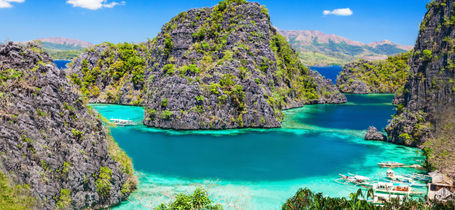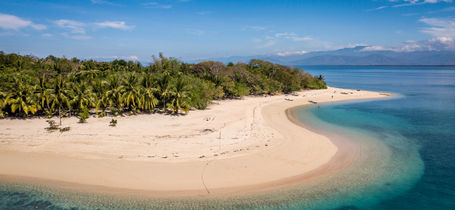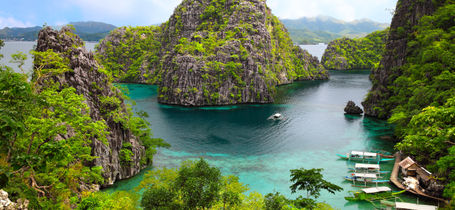Coron Diving
Coron combines dramatic natural beauty above the water, made up of dark limestone cliffs and emerald jungle, with some truly awesome diving. Known as one of the best places in the world to wreck dive, this region claims no less than eight beautifully preserved Japanese WWII wrecks. With paradise beaches, crystal clear halocline lakes and healthy reefs to dazzle divers too, Coron will not disappoint.
Diving in Coron
Coron is a province located on the island of Busuanga. It is part of the larger Palawan region of the Philippines. Busuanga Island has several popular tourist destinations aside from Coron, including Concepcion waterfalls.
Coron is actually two places - the eastern region of Busuanga (and the fishing town which is the main population hub) and an island of the same name, usually accessed by day trips from Coron Town. One of the ways to access the town is to get a boat from San Jose on Mindoro Island. The town is well known for its diving and has several dive resorts - though there are more independent dive centers too.
It is a popular place for diving and as such, all the dive centres and resorts offer dive courses, but it is not the most popular place for beginners. Much of the diving appeal in Coron is the wrecks, many of which are inaccessible to open water divers. However, for divers doing an advanced or technical course, there is wreck diving galore! There are also some liveaboards which frequent this area if you wish to dive in other locations too.
Wreck diving is far from the only diving opportunity here. There are caves to dive at the Cathedral. There are two lake diving opportunities on Coron Island - Barracuda and Kayangan. There are also several beautiful reefs - such as Bugor Reef and the house reefs.
Best time to dive
Coron diving, much like the rest of the Philippines, is governed by a yearly monsoon. Though it is possible to dive in Coron all year round, certain times of the year provide better conditions.
The dry season runs from November to May. It brings minimal rainfall and winds, which makes for calm and predictable diving conditions. The temperature does vary during this time. The air temperatures stay pretty constant at around 28oC year round but the water temperatures can vary between 25 and 31oC depending on the month. December - February is the coldest, whereas April/May is the hottest.
The only downside to diving at this time of year is that it is peak season and all the resorts will be at their busiest. Prices may increase slightly compared to low season, particularly around major holidays like Christmas, New Year and Easter. These times will also fill up fast so be sure to book in advance.
The rainy season is from June to October and brings with it faster winds and a dramatic increase in rainfall. Though it is still possible to dive at this time, and the water temperatures are actually very consistent, potential typhoons may prevent dive trips from running. You may experience good weather during this time too, but be aware of the potential for a wet trip. On the plus side, it was already wet in the ocean!
Types of diving
The reef diving in Coron is awesome - the corals are very healthy and host an abundance of fish and macro life. Bugor reef is a great example of this. These are popular with beginner divers, as are the house reefs found from the shore. This location has the rare accolade of being able to offer both salt and freshwater diving - in the same dive. Barracuda Lake offers a unique combination of the two, and a jungle hike thrown in! You can also dive in one of Coron’s other 11 lakes - Kayangan. Some dives have swim-throughs and cave/cavern diving, notably Cathedral Cave which offers beautiful filtered sunlight and a stalactite filled chamber.
Coron’s diving is famous, however, for its abundance of remarkably intact, Japanese WWII wrecks. On the 24th of September 1944, a group of 180 Hellcat and Helldiver planes burst out of the sky. They had been ordered to take out as many of the Japanese fleet as possible, sinking at least 8 of the warships, leaving them entombed on the ocean floor.
These wrecks offer spectacular opportunities for wreck diving for all levels. Though most lie at advanced depths (30m) and beyond, there are several which can be dived by open water divers. Many are intact and can be penetrated from a variety of locations. Artefacts such as guns, ammunition and building materials can be found littering the wrecks and surrounding seabed. Due to the fact that many of the remains still contain live ammunition, it is very important not to move or take anything from the wrecks.
What to see
Often the marine life is not the main topic of conversation when reading about diving in Coron, but it is still very impressive. Besides the wrecks, there are also plenty of reefs to explore too.
Most dive sites have lots of fish surrounding them. Schools of jacks, snappers, barracuda and Spanish mackerels are common sights. Colourful reef fish dart here and there, living everyday life on the reef - butterflyfish, angelfish, parrotfish, surgeonfish, pufferfish, groupers, sweetlips and fusiliers. Curious batfish will glide by, particularly on the wrecks, to learn more about you. Flamboyant lionfish, ugly scorpionfish and stonefish hide in plain sight.
Macro life here is not the most impressive in the Philippines but will keep most muck divers happy for a dive or two. Nudibranchs are here in abundance. Orangutan crabs, hairy squat lobsters and glass shrimp are some among the many, many crustacean species that hide in anemones, corals and rocks.
Bigger fish can be seen at certain dive sites. Stingrays, moray eels, octopus and cuttlefish can all be seen, either laying on the sandy bottom or camouflaged in rock crevasses. Tuna and trevally hunt in the depths. Green turtles are frequent visitors to most reefs, gorging themselves on coral. White tip and blacktip reef sharks can be seen at some deeper sites, hiding in caves and stalking the waters. Rare finds like leopard sharks and guitar sharks have been known here.
Best places to dive
Irako - A 200m Japanese supply ship lying at around 45m, Irako demands an advanced certification and certain penetrations, such as the engine room, require technical or wreck diving expertise. You can also penetrate the wheelhouse, cargo hold and decks more easily. The visibility is often excellent so you can get the full scale of her. She is mostly intact and is often referred to as the best wreck dive in Coron. Irako is also surrounded by marine life.
Akitsushima - A 118m long seaplane carrier lies at 36m on her port side. Still mostly intact, you can penetrate the impressive engine room where you can see the engines and lots of machinery. Other points of interest are an anti-aircraft gun and a large crane. It is an advanced dive due to the depth and sometimes strong currents. There is less marine life than some sites but there are still lots of batfish, tuna and barracuda.
Barracuda Lake - After a short 15-minute mountain hike in scuba gear (no, really), you will reach this almost lunar landscape. This lake lies inland on the island of Coron and despite its name, does not have any barracuda. It has a layer of freshwater which is around 28oC laying on top of salt water, which starts at around 38oC and, surreally, gets warmer as you go deeper until you reach the undulating silt lake bed. This is due to the thermal springs which warm the lake. Though there aren’t many fish to look at, this is a fascinating geological dive, with many limestone pinnacles and stunning visibility.
The Cathedral Cave - A tunnel at around 6 - 10m leads into the rock, and you will see sunlight shining through. It opens into a chamber with a “window” above sea level, filling the chamber with ethereal, blue light. A further passage leads to a submerged chamber with an air pocket so you can surface and observe stalactites.
Okikawa Maru - This 170m long tanker lies upright, with her main deck lying at 12m, making her accessible to all levels of divers. Many parts can be penetrated including the prop shaft and engine room. Her deepest point is at 26m and she is surrounded by fish and covered in soft corals and macro life.
The Olympia Maru, Kogyo Maru, Kyokuzan Maru, Tangat Wreck, Lusong Gunboat, Sangat Gunboat, Nanshin Maru Skeleton Wreck make up the other dives in the area, all of which are spectacular dives.


